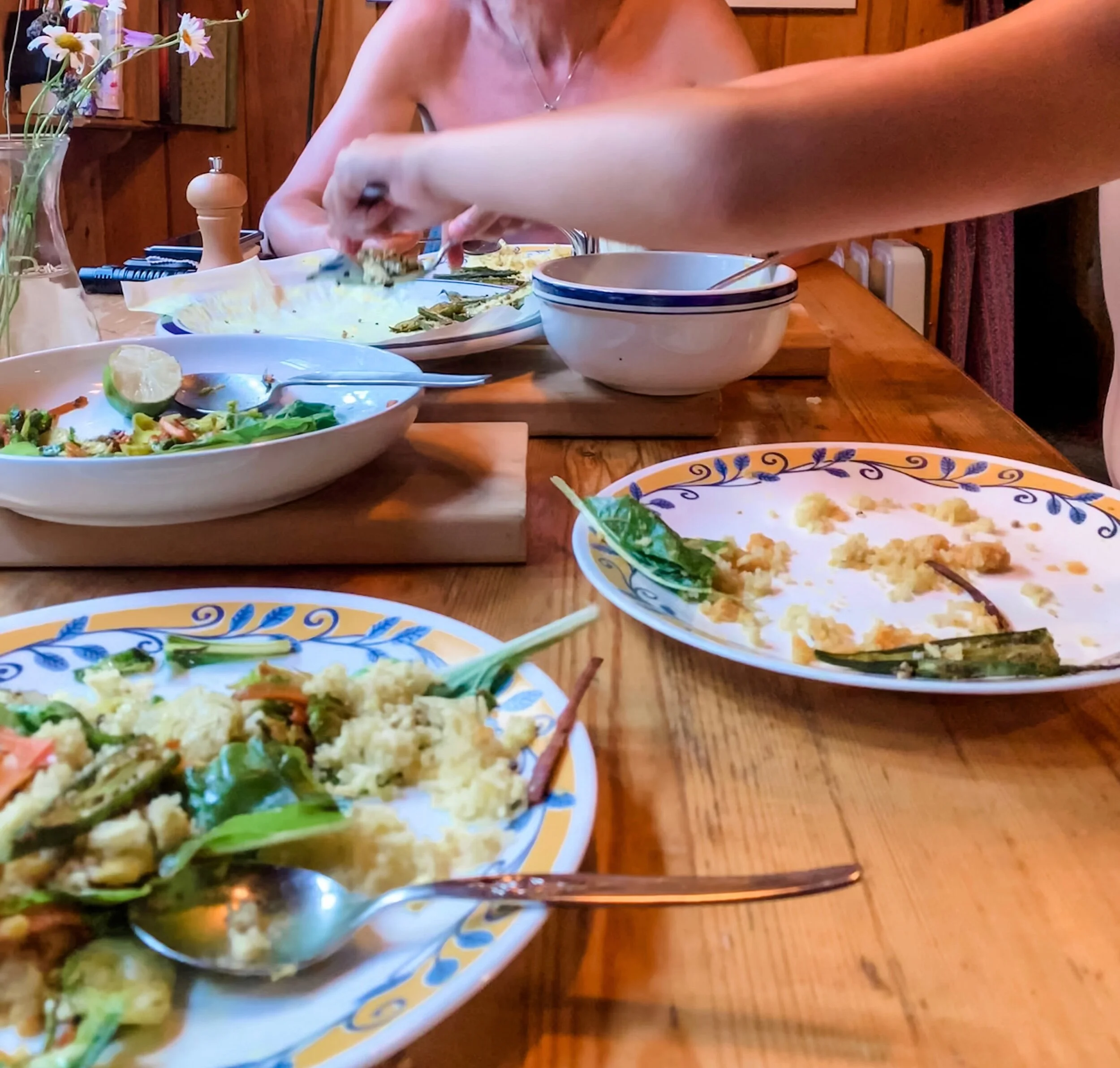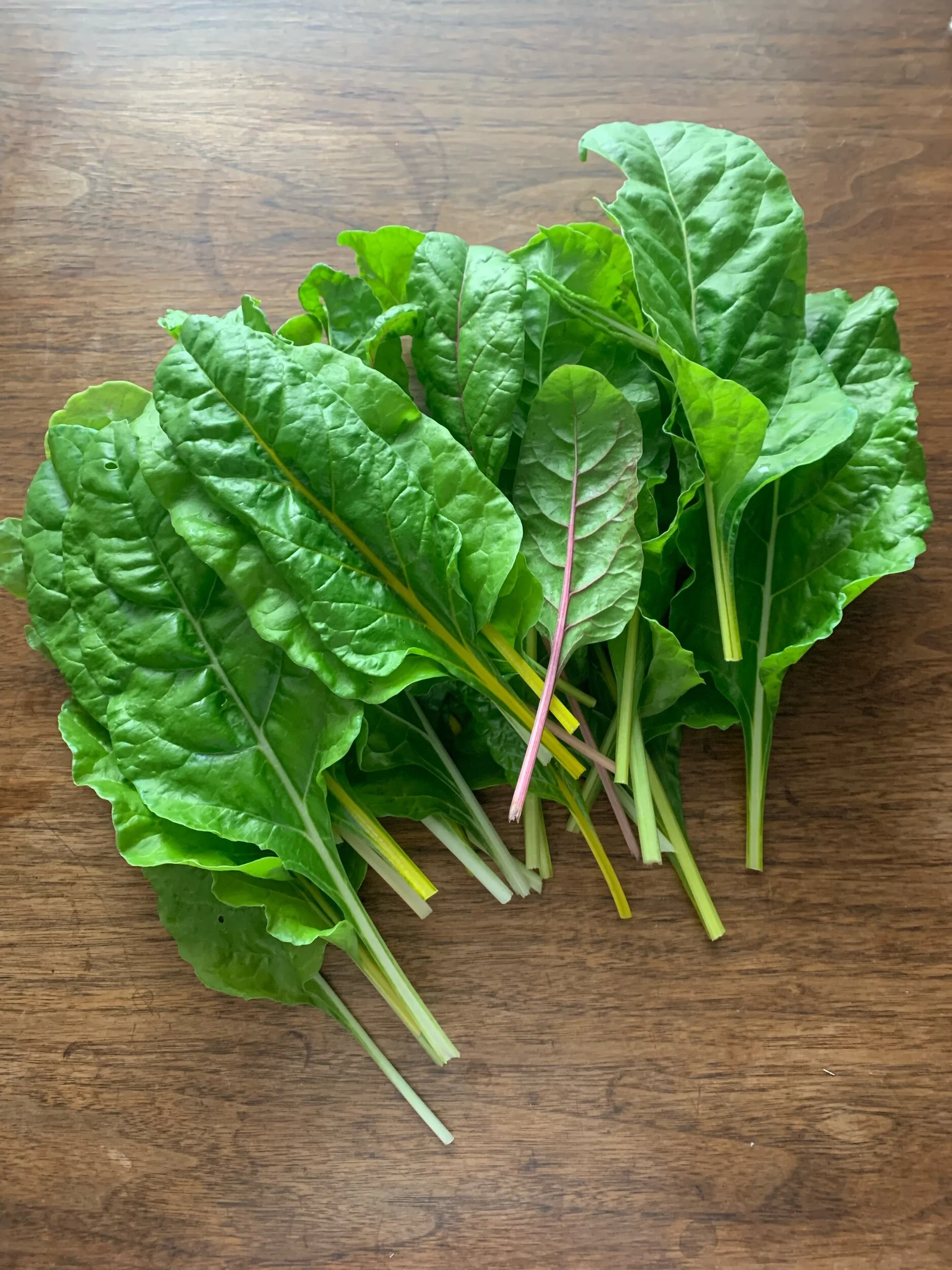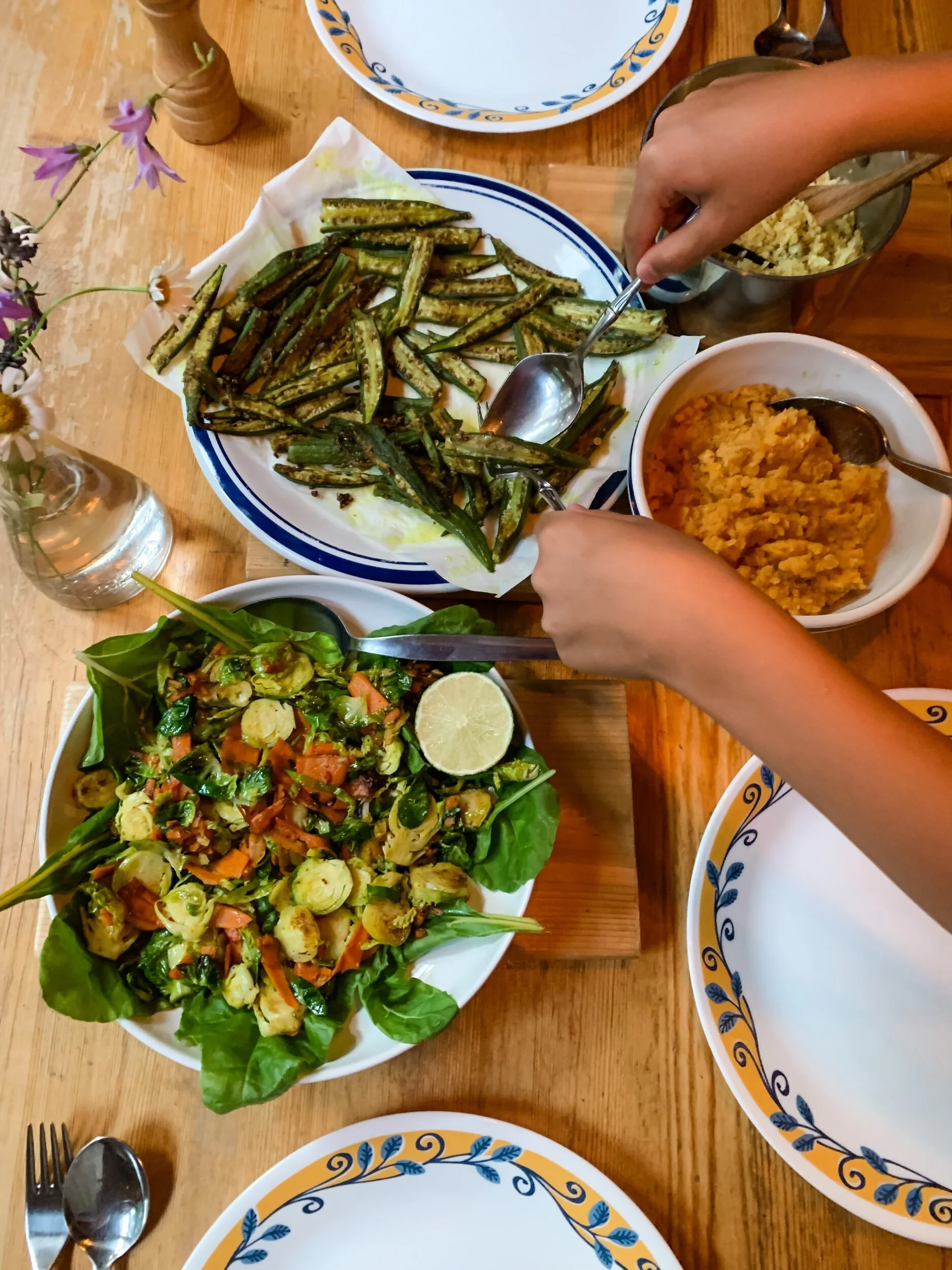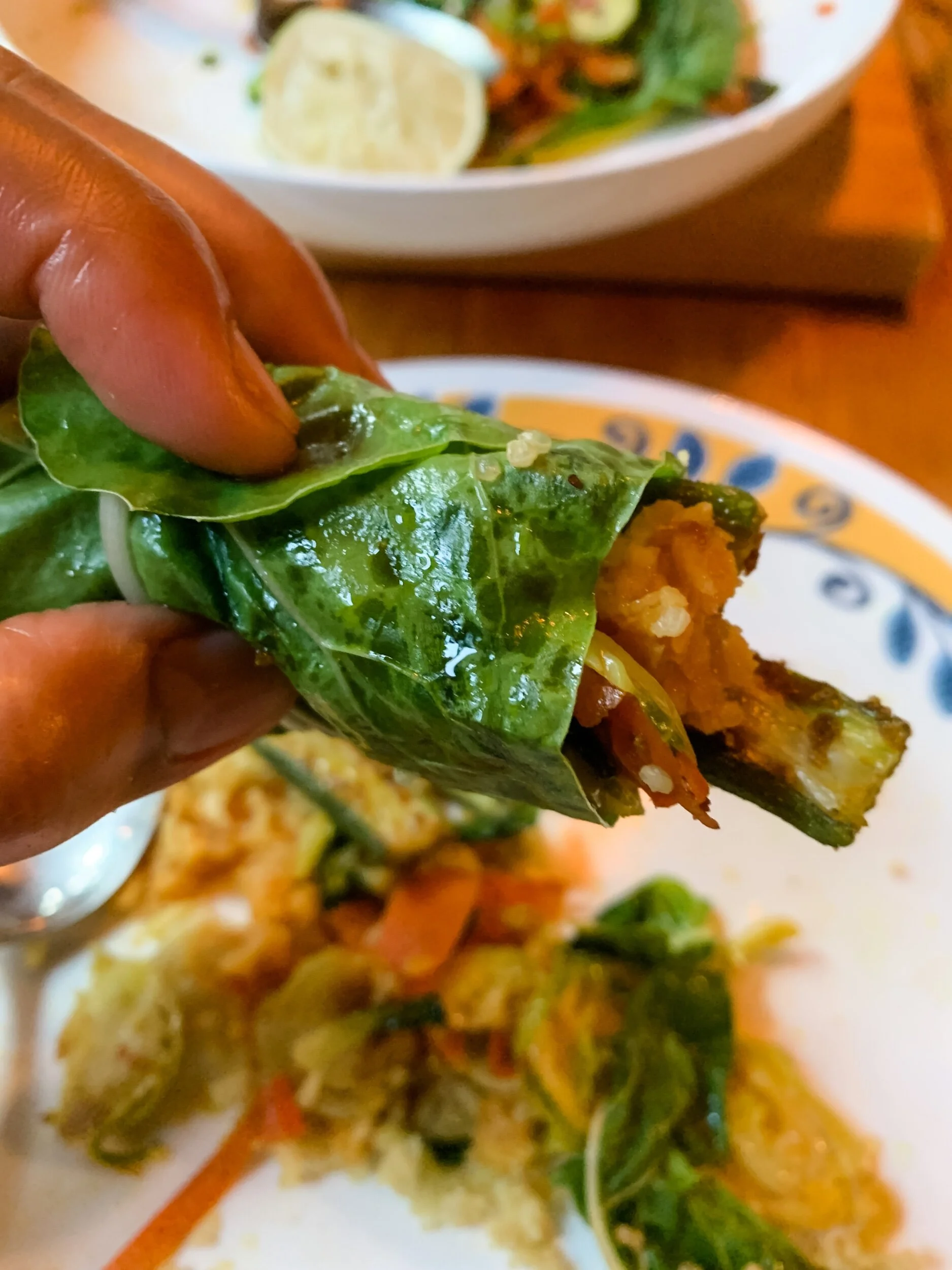Rainbow Chard Rolls
Hi and welcome! I’m Evangeline—mom, Registered Massage Therapist, Yoga teacher, and lover of all things health and wellness. I started this blog back in the early days of Covid19 as a way to stay in touch with my clients, and it’s grown into a space to share what I love most. Here you’ll find simple, nourishing recipes I make for my family, sprinkled with Ayurveda and Yoga wisdom. My hope is that these posts inspire you to care for yourself in small, joyful ways and feel a little more balanced in everyday life.
Here in cottage country, the nights are beginning to cool—over the past few days, temperatures have dipped as low as 9°C. As I look back over the meals we’ve shared during these warmer months, one dish stands out as a favourite: Rainbow Chard Rolls.
Cook What You Have
This recipe came about quite organically—literally. The idea to roll up dinner came from my son. Watching him at the table, I copied what he was doing, and voilà—a recipe was born!
We were nearing the end of a two-week stay at a cabin, and it was time to use up the last of the vegetables in the fridge. That night’s assortment included carrots, Brussels sprouts, broccoli, and okra. The only plan I had was to lay out the raw rainbow chard leaves in a shallow dish and top them with the warm, sautéed vegetables to gently wilt them.
There happened to be enough okra to make a small batch of okra fries, which we served on the side—but later ended up wrapping them in the chard rolls too!
The rolls were stuffed with a hearty mix of grains, red lentils, and vegetables, brightened with fresh thyme and mint from our little herb garden. Combining grains and lentils creates a complete protein, making this dish not only flavourful but also nourishing. If fresh herbs aren't available, dried versions will work just as well.
Rainbow chard leaves - harvest from our little backyard garden before it got packed up for cottage country, a two and a half hour drive. These lovely, delicate, yet hardy green leaves lasted the two weeks we were up in the cabin, kept in the fridge in an air tight container. Chard seeds came from Beech Garden on Vancouver Island.
A Handy Tip
In hindsight, laying out all the chard leaves with the stems pointing outward makes them easier to grab and roll—especially when everyone’s serving themselves at the table. That said, it worked just fine as we went, and there’s something joyful about the spontaneity of hands-on meals.
I hope you enjoy making your own Rainbow Chard Rolls as much as we did. It’s a recipe rooted in seasonality, creativity, and the simple pleasure of using what’s on hand—right down to the last okra.
Rainbow Chard Rolls
Servings: 3-4 rolls per person depending on size of leaves
Prep Time: 20 minutes
Cook Time: 45 minutes
Components:
WRAPPer:
Rainbow Chard leaves, 3-4 per person
Filling:
1. Spiced Grains
2. Summer Spiced Red lentils
3. Vegetables with thyme and mint
SIDE:
Okra Fries - here is the recipe
SAUCE/DIP:
I suggest Cilantro Chutney - here is the recipe or simply squeeze lime juice over the rolls, which is what we did that night.
Lay out all all the veGetables, grains & lentils
1. Lay out the chard leaves with stems pointing outwards on a serving platter. Set aside.
2. Separate the 3 parts of the filling and their ingredients.
3. If you’re making okra fries and the cilantro chutney dip this will take another 20 minutes to prepare, plus the bake time for the okra.
Let’s begin:
Preheat the oven to 350°F/177°C for the okra fries. Recipe here.
Make the cilantro chutney. Recipe here.
Follow the steps below for the 3 parts of the filling: Grains, Lentils, Vegetables
1. Spiced grains
Makes 2-3 servings
¼ cup quinoa
¼ cup basmati rice
¾ cup water
1 inch cinnamon stick
3 cardamom pods
3 cloves
⅛ tsp turmeric
⅛ tsp cumin
½ tsp ground fennel
½ tsp ground coriander
1 tsp ghee or olive oil
Soma salt to taste
Rinse grains very well. Place grains, spices, ghee/olive oil and water in a medium-size pot on the stove on high heat. Let boil for 5 minutes, stirring occasionally. Cover with a lid and turn off stove and let steam for 15 minutes. Salt to taste before serving.
2. SUMMER RED LENTILS
Makes 2-3 servings
⅔ cup red lentils, rinsed well until water is clear
1 cup
1 tsp summer spice mix - here is the recipe for my Summer Spice Mix
1 - 2 tsps ghee or olive oil
Soma salt to taste
While the spiced grains are cooking, rinse the red lentils very well. Place the lentils, summer spice mix, ghee/olive oil and water in a small pot on the stove on high heat. Let boil for 5 minutes, stirring occasionally. Cover with a lid and turn off the stove and cook for another 10-15 minutes. Before serving, salt to taste.
While the grains and lentils are cooking, prep the vegetables. Leave the grains and lentils on the stove, and keep the lid on them to keep them warm and fresh before bringing to the table.
3. VEGETABLES WITH THYME & MINT
3-4 cups vegetables
2 tsps dried thyme leaves or a few sprigs of fresh thyme
1 -2 tsps ghee or olive oil
2 tsps dried mint or 8-10 mint leaves, torn
Soma salt to taste
Cut the vegetables in cubes, or thinly sliced. Add ghee/olive oil in a pan on medium heat. Cook hard vegetables first, then add thyme and softer vegetables next. Cook until vegetables are glistening, then cover with a lid and cook for another 5 minutes. Just before serving, sprinkle mint leaves and add salt to taste.
Balancing Pitta in the Summer Season: An Ayurvedic Perspective
In Ayurveda, all life is made possible through the dynamic balance of the five elements of nature (panchmahabhutas):
Space (ākāsha), Air (vāyu), Fire (agni), Water (jala), and Earth (prithvi).
Life on Earth depends on the sun and the moon, and their perfect relationship with our planet. From an Ayurvedic perspective, these celestial bodies emit vibrational energies composed of these five elements in varying proportions.
According to Shaka Vansiya Ayurveda (SVA), the five elements are embodied in the following ways:
The Sun emits agni energy – primarily fire, with some water
The Moon emits soma energy – governed by water and earth
Movement and flow of these energies is necessary for life, and this dynamic movement is called marut – composed of space and air
Together, agni (sun/fire), soma (moon/water–earth), and marut (space–air movement) form the three vibrational energies that give rise to prana—the life force.
Known as chi in Traditional Chinese Medicine, prana is the subtle energy that flows through all living beings. It animates our bodies, energizes the food we eat, the water we drink, and the air we breathe—sustaining life and vitality everywhere.
Understanding Summer Through the Lens of Ayurveda
Summer is naturally a time of agni—it is the hottest season, and thus, governed by the pitta dosha, which is made up of mostly fire, with a little water.
The three doshas express our inner relationship with the elements:
Vata – governed by space + air
Pitta – governed by fire + water
Kapha – governed by water + earth
In both nature and the body, “like increases like”. For example:
Adding more chili makes a dish hotter.
Doing more pitta-aggravating things (heat, stress, spicy food, overexertion) increases internal heat.
In summer or in hot climates, it’s easy for pitta to become aggravated—but we often don’t notice it until it expresses through discomfort.
Common Signs of Pitta Imbalance
Acid reflux or heartburn
Red, inflamed, or sensitive skin
Ulcers or overheating
Irritability, impatience, “hangry” feelings
Recurring headaches
Emotional volatility
SVA Recommendations to Balance Pitta (Especially in Summer)
Lifestyle
Sleep early, ideally before 10pm so the liver does not aggravated or over-heated (pitta time is between 10pm-2pm)
Avoid intense exercise between 10am–2pm and 10pm–2am
Stay hydrated
Avoid alcohol
Meditate and slow down your pace
Diet
Avoid skipping meals – don’t let yourself get “hangry”
Minimize fried foods, processed foods, refined vegetable oils and excessive supplements (especially fat-soluble vitamins A, D, E, K, and fish oils – they can all overheat the liver)
Reduce very spicy and sour foods
Use lime over lemon – more alkaline and sweet in its post-digestive effect
Eat sweet juicy fruits
Cook with ghee or pure olive oil
Add cooling spices and herbs like fennel and coriander, dill, mint, rosemary
Use less turmeric (can heat the liver); instead, try curry leaves, less heating to the liver
Use soma salt (gentler and cooling compared to regular salt)
Herbal & Skin Support
Tea blends with fennel, coriander, rosehip, rose petals, DGL (deglycyrrhizinated licorice), or Indian sarsaparilla
Use skin care with vetiver, aloe vera, rose, jasmine, neem, jojoba, or coconut oil
Bathe with rose or lavender oils or flower petals
Spritz face with rose water
Use rose quartz or jade rollers for gentle self-massage
Vibrational & Subtle Therapies
Wear cotton clothing for breathability and comfort
Use cooling gemstones like pearl or rose quartz
Wear sandalwood or tulsi prayer beads (japamalas)—they carry soma (lunar) energy to cool the heart and calm the mind
Practice pranayama (cooling breathing techniques):
Sheetali
Sheetkari
Chandra Bhedana
Nadi Shodhana
Chant mantras to balance the vibrational body
Meditate to stay steady, clear, and connected
References
Vaidya Mishra- Shaka Vansiya Ayurveda, Notes from lectures, courses, workshops and conferences, 2003-2015
Sri Sri Yoga- Notes from SSY 300-Hour Yoga Teacher Training, 2020




